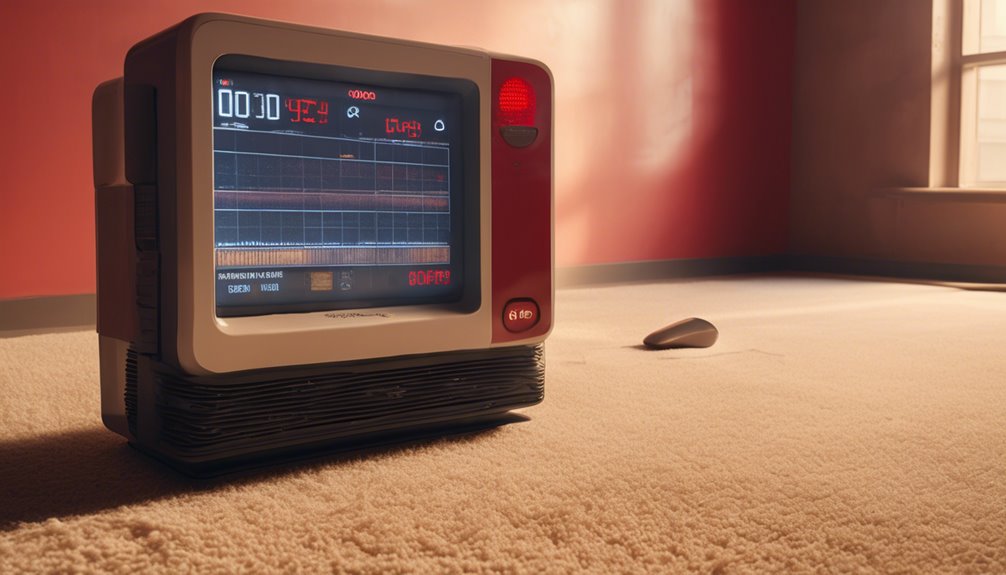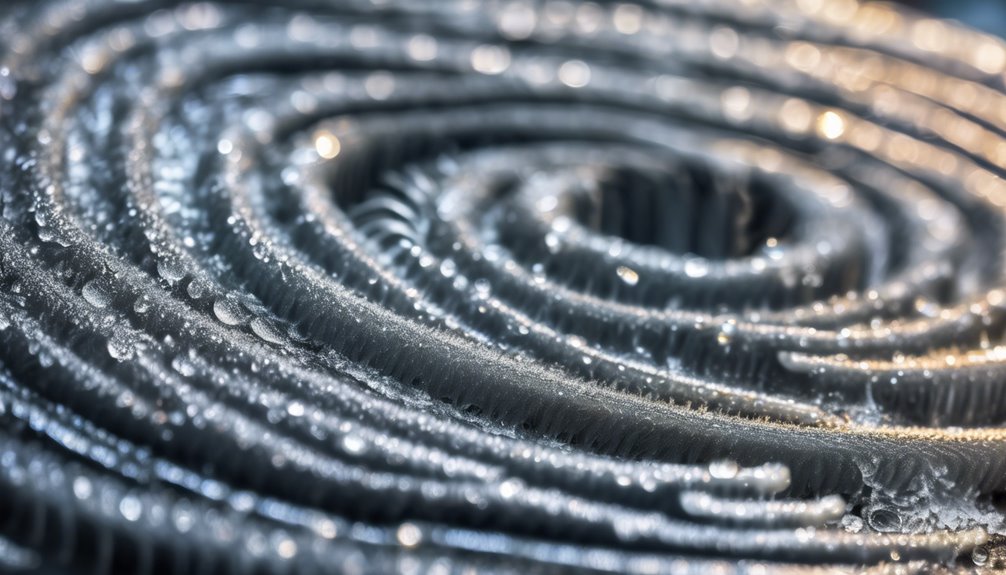To fix your AC's water leakage problem, start by identifying the source of the leak. Turn off the unit and inspect the air filter, drainage system, and condensate drain pan for blockages or damage. Check for refrigerant leaks and ensure the drainage hose and connection are secure. Dry the area and restart the AC. If the issue persists, you may need to dig deeper to resolve the problem – and we'll guide you through it.
Key Takeaways
- Inspect the AC's drainage system for blockages, kinks, or damage, and check for signs of water damage or mineral buildup around the unit.
- Turn off the AC unit and inspect the air filter, replacing it if it's old or damaged, to ensure proper air purification and prevent further water damage.
- Clean the AC's drainage system by removing dirt and debris, and use a soft brush or cloth to clear any clogs in the drainage tube.
- Check the AC's refrigerant levels, installation, and thermostat function to ensure they are within recommended ranges and properly secured.
- Monitor the AC's performance and address any recurring water leakage issues promptly to prevent further damage and consider upgrading to a more efficient model.
Identify the Source of the Leak
When your air conditioner is leaking water, it's essential to pinpoint the source of the leak to prevent further damage.
You'll want to act quickly to avoid costly repairs or even mold growth. Start by inspecting the unit's drainage system, checking for blockages or kinks in the condensate drainage tube.
Look for water damage signs, such as water spots or puddles, near the AC unit or on the walls and ceiling.
Use leak detection methods like a flashlight and a cloth to identify where the water is coming from.
Check the condenser coils, drain pan, and refrigerant lines for signs of moisture or water accumulation.
Turn Off the AC Unit
Turn off the AC unit immediately to prevent further water damage.
This is an urgent maintenance task that requires your prompt attention. Don't delay, as water leakage can cause significant damage to your AC system and surrounding structures.
- Unplug the AC unit from the power outlet to ensure it doesn't continue to operate.
- Switch off the circuit breaker or fuse that controls the AC unit.
- Check your thermostat to ensure it's set to "off" mode.
- Verify that the AC unit has completely shut down before proceeding with further maintenance tasks.
Inspect and Clean the Air Filter
You'll want to take a close look at your air filter, as its condition plays a significant role in preventing water leakage.
A dirty or clogged filter can lead to frozen coils, which in turn cause condensate to overflow, resulting in water leakage.
Filter Condition Matters
A dirty air filter can wreak havoc on your air conditioner's performance, leading to reduced airflow, increased energy bills, and even water leakage.
You mightn't realize it, but a clogged filter can cause your AC to work harder, leading to condensation buildup and eventually, water leakage.
To avoid this, make sure to inspect and clean your air filter regularly.
Here's what you should look for:
- Check the filter quality and replace it if it's old or damaged
- Ensure proper air purification by cleaning or replacing the filter every 1-3 months
- Look for signs of mold, dust, or debris accumulation on the filter
- Verify that the filter is properly installed to prevent air leaks
Cleanliness Is Key
You're probably aware that a dirty air filter can cause your AC to work harder, leading to increased energy bills and reduced airflow.
What you mightn't know is that it can also cause water leakage. Daily maintenance is crucial to prevent this issue.
Make it a habit to inspect and clean your air filter regularly. A clean filter ensures proper airflow, reducing the likelihood of condensation buildup and subsequent water leakage.
As part of your regular upkeep, set a reminder to check and clean your filter every 1-2 months, depending on usage. This simple task can save you from the hassle of dealing with water damage and costly repairs down the line.
Check the Drainage System
You'll want to inspect the drainage system to ensure it's functioning properly, as a blockage or clog can cause water to accumulate and leak out.
Check for any obstructions in the drainage path that might be preventing water from flowing freely. Additionally, make sure the drain pan is clear of debris and not clogged, as this can also lead to water leakage.
Drainage Path Obstruction
Clogged air conditioning drainage systems are a common culprit behind water leakage issues.
When you neglect to clean or maintain your AC's drainage system, it can lead to a drainage blockage, causing water accumulation and eventually, leakage.
Check your drainage system for any obstructions that might be hindering the flow of water.
- Look for kinked or bent drainage tubes
- Check for dirt, dust, or debris buildup
- Ensure that the drainage system is properly sloped
- Verify that the drainage tube isn't clogged with ice or frost
Clogged Drain Pan
Now that you've checked the drainage system for obstructions, it's time to focus on the drain pan itself, which can also cause water leakage if clogged. A clogged drain pan is a common issue that can lead to water accumulation and leakage. To avoid this, perform regular drain maintenance by inspecting the pan for dirt, debris, and rust.
| Clogged Drain Pan Issues | Consequences |
|---|---|
| Dirt and Debris Buildup | Water Accumulation |
| Rust and Corrosion | Pan Damage |
| Improper Installation | Water Leakage |
| Lack of Maintenance | Frequent Clogs |
| Ignored Warnings | AC Malfunction |
During pan inspection, look for signs of clogging, rust, or corrosion. Clean or replace the pan as needed to ensure proper drainage and prevent water leakage.
Look for Refrigerant Leaks
Refrigerant leaks are a common culprit behind AC water leakage.
These leaks can cause water to accumulate around your AC unit, leading to further damage.
To identify refrigerant leaks, you need to understand refrigerant properties, such as their ability to change state from liquid to gas. This knowledge helps you detect leaks more effectively.
You'll need specialized leak detection tools, such as:
- Electronic leak detectors
- Ultraviolet (UV) dye kits
- Refrigerant leak-down testers
- Soap bubble solutions
These tools help you pinpoint the source of the leak, allowing you to take corrective action to fix the issue and prevent further water leakage.
Inspect the Condensate Drain Pan
Your air conditioner's condensate drain pan is another crucial area to inspect when dealing with water leakage issues.
During pan inspection, check for any blockages, dirt, or debris accumulation that might be hindering proper water flow. Ensure the pan is level and securely fastened to the AC unit.
Check for blockages, dirt, and debris in the pan, and ensure it's level and securely fastened to the AC unit.
You should also inspect the pan's drain for any signs of corrosion or damage. Proper drain maintenance is essential to prevent water accumulation and subsequent leakage.
If you find any issues, clean or replace the affected parts as needed. A well-maintained condensate drain pan will help prevent water leakage and ensure your AC operates efficiently.
Check the Drainage Hose and Connection
The drainage hose and connection are critical components that require attention to prevent water leakage in your air conditioner.
You should inspect the drainage hose regularly to ensure it's not clogged or damaged. A faulty hose can cause water to accumulate and leak from your AC.
- Perform a visual hose inspection to check for cracks, kinks, or blockages.
- Check the connection to ensure it's securely tightened to prevent water from escaping.
- Make sure the hose is properly sloped to allow water to flow freely.
- Consider replacing the hose if you find any signs of damage or wear.
Dry the Area and Restart the AC
After fixing the drainage hose and connection, it's essential to dry the area around your air conditioner to prevent further water damage.
You can use towels or a mop to soak up as much water as possible. Then, create dry air circulation around the AC by turning on a fan or opening windows. This will help speed up the evaporation process.
Soak up excess water with towels or a mop, then boost evaporation with a fan or open windows.
As you dry the area, perform wet spot detection to ensure you don't miss any waterlogged spots. Check for signs of water damage, such as warping or discoloration, and address them promptly.
Once the area is dry, you can restart your AC. Make sure it's working correctly and not leaking water before considering the issue resolved.
Frequently Asked Questions
Can I Fix an AC Water Leakage Problem on My Own?
You can definitely tackle DIY troubleshooting on your own, but before diving in, make sure you have a DIY toolkit equipped with essentials like screwdrivers, pliers, and a wrench to help you identify and potentially fix the AC water leakage issue.
How Long Does It Take to Fix an AC Water Leak?
You'll likely spend around 30 minutes to an hour detecting the leak, and another 1-2 hours repairing or replacing the faulty part, depending on the complexity of the issue and your DIY skills, setting your repair timeline.
Will a Water Leak Affect My Ac's Cooling Performance?
You'll likely notice a drop in your AC's cooling capacity if you have a water leak, as it can cause water damage to the unit's internal components, reducing airflow and overall performance.
Can I Use a Dehumidifier to Reduce AC Condensation?
You're wondering if a dehumidifier can reduce AC condensation. Yes, it can! By removing excess moisture from the air, a dehumidifier's benefits include minimizing condensation causes, which in turn, helps your AC work more efficiently.
Will Fixing an AC Water Leak Increase My Electricity Bill?
You're wondering if fixing that AC water leak will hike your electricity bill. The answer is yes, as leak detection methods reveal hidden issues, and resolving them can impact energy consumption patterns, leading to increased costs.
Conclusion
You've successfully identified and fixed the AC water leakage problem. Make sure to regularly inspect and clean the air filter, check the drainage system, and look for refrigerant leaks to prevent future issues. By following these steps, you'll be able to enjoy cool air without worrying about water damage. Remember to dry the area completely before restarting the AC to ensure safe and efficient operation.



